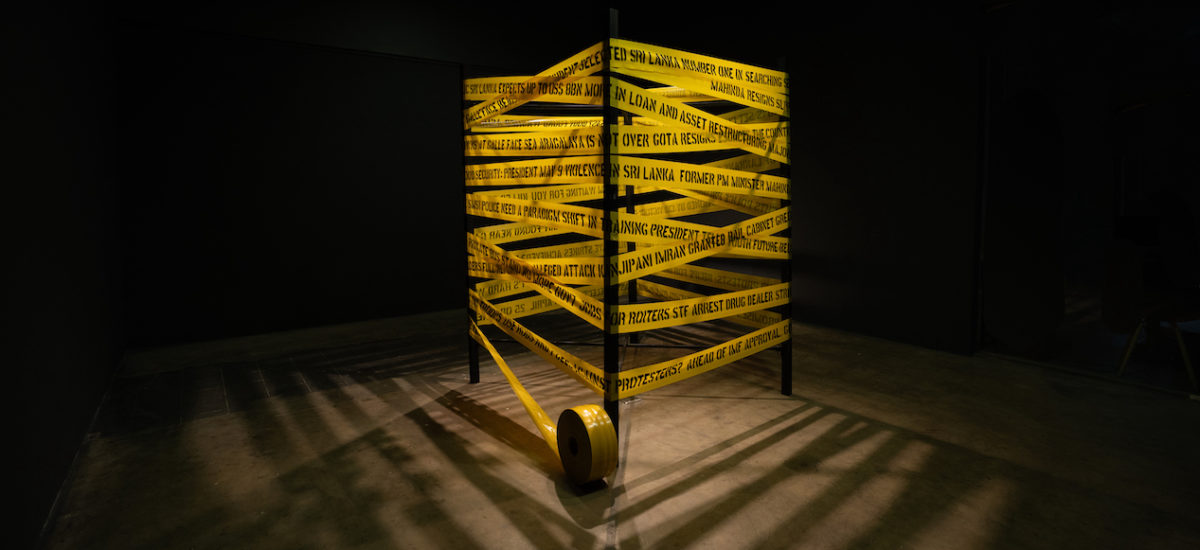In his exhibition Dystopia at the Saskia Fernando Gallery, Hashan Cooray explores societal and political challenges through a metaphorical lens. It features paintings and two installations that confront the complex relationship between an individual and the socio-political systems within which they exist. One installation comprises 60 metres of newspaper headlines from the 2022 Aragalaya protest movement and the aftermath.
His work incorporates drawing, painting, digital art, installation and mixed media to break away from traditional portraiture to uncover the human psyche. Repurposing propaganda posters and commercial advertisements, Cooray attempts to confront the way in which society is caught up in the web of nationalism, capitalism and consumerism.
His work has been featured in group and solo exhibitions at Saskia Fernando Gallery, the Lionel Wendt Art Centre and the JDA Gallery. He has been featured in the Imago Mundi Book Project published by the Benetton Foundation. His work in the advertising sector influences his art, as he looks at how the unconscious mind is negatively impacted by capitalist and consumerist forces.
In an interview with Groundviews Hashan Cooray spoke about the inspiration and themes behind his work.
What inspired you to create Dystopia?
I wanted to see a better world than what we experience in day to day life. There are so many things that happen in our daily lives as a citizen of a third world country. There are so many things I see in both my professional and personal life. We face various challenges whether they are social, political or related to political agendas. As a citizen, a thinker and an artist, many ideas spark in my mind simultaneously. This is where I decided to move from my usual path. I wanted to explore my desires, the country’s desires and the political leaders’ desires. These perspectives and ambitions are very different. Each of us has different goals to achieve in life. I wanted to see how these desires and problems impact our country and the contemporary situation. I wanted to see how our cultural lives intersect with these contemporary issues. This was the spark that led me to move away from my previous artistic path. While I was reading, I came across a metaphorical world called dystopia. That world seemed better than our current reality. There are many things we need to achieve compared to our desires and we are far from that ideal. We are far from our dreams. It’s like seeing a better place that is far away like the Milky Way while we are in a dark hole. This is how I see it; we are in a dark hole and that ideal world is far away from us. The work is very demanding. Installation art requires people to engage with it. You can’t fully understand it without experiencing it in person. It’s different from traditional paintings or sculptures. Installation art engages people in a 360 degree experience. This is what we do as a country; we go around problems without solving them and we engage with cultural norms in various ways. It’s part of the experience.
What is the significance of the typography?
I actually work in the advertising industry so my ideas are not just digital but mainstream. The advertising practice supports me in gathering and refining my ideas. It helps me create and solve problems through research. My art practice is influenced by this but my inspiration comes from a logical place. Logical theories and composition theories are part of my work. Typography is another element for me. I sometimes bring in iconic brands like Coca-Cola not just as brands but as symbols of larger issues. For example, in a third world country, people may struggle to afford three meals a day but companies still sell Diet Coke. It’s a paradox. I mention those terms so that it becomes more specific for the viewer to read the idea in the paintings. It’s like literature; there’s always meaning behind it. I think even the colors are significant. They represent the dark side of life. It’s an industrialised version of reality. My work is about making people think and see beyond the obvious.
What are the most thought provoking paintings here?
The hopscotch art. It is a significant piece where the first few boxes are vertical, symbolising unreachable ambitions. It’s about people trying but getting stuck due to barriers. It also has a nostalgic feeling, reflecting my childhood experiences. My studio was small but I wanted to create big work. My academic readings and casual readings influenced my work. The significance of the world I depict is tied to hope, justice, peace, friendship and good lives. These are the ideals we strive for in the tangible world. My favorite piece is one that combines human, monkey and goat faces. It explores inherent and biological values, creating an unknown but intriguing image. It’s about bringing different elements together to create something new and thought provoking.
Do the paintings signify hope, justice, peace and good lives?
Yes, those are the hooks we need to achieve as a country. Peace, justice and good lives are essential, but we are far from them. It’s about how politicians and political agendas play with our cultural values and trigger certain points. They misuse cultural norms and my work reflects that. For example in one of my paintings, the body of work is related to wood carvings and human figures showing the connection between cultural icons and human experiences. People need to engage with art meaningfully. Art is a peaceful way of expressing oneself and one’s desires. It’s about educating through experience. People tend to forget history quickly and you want to bring it back through your work. These paintings are simple to understand but has a complex structure. It’s about going beyond the surface and understanding the deeper meanings.
Photos from Saskia Fernando Gallery and Ama Koralage

